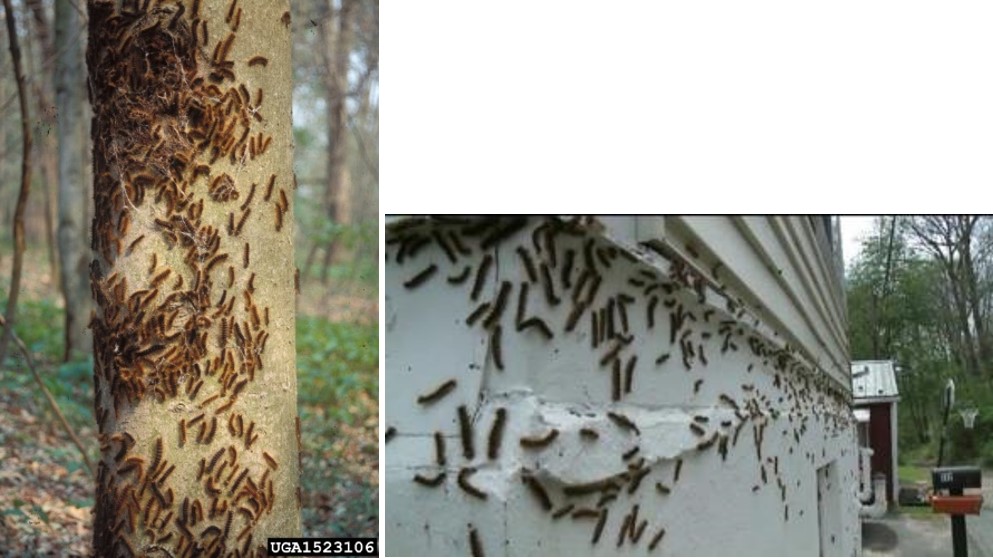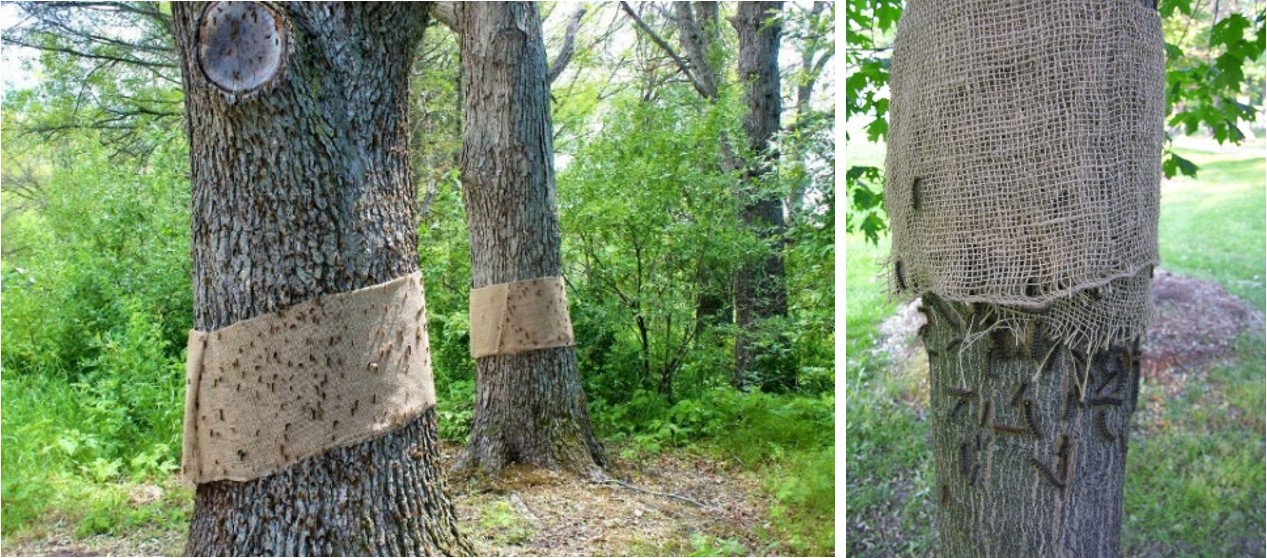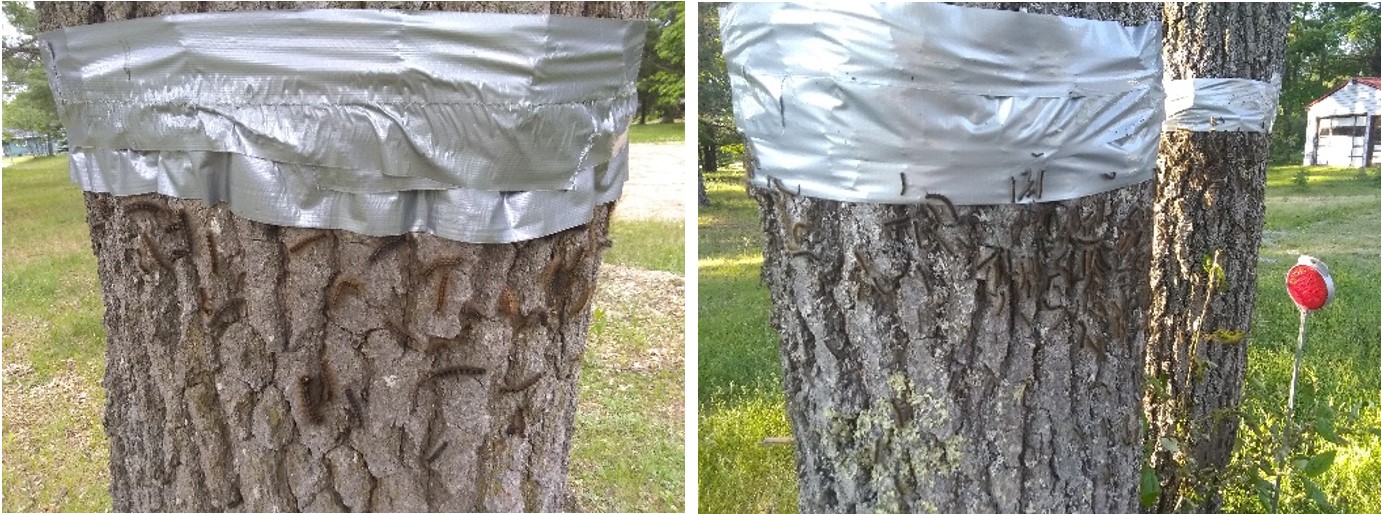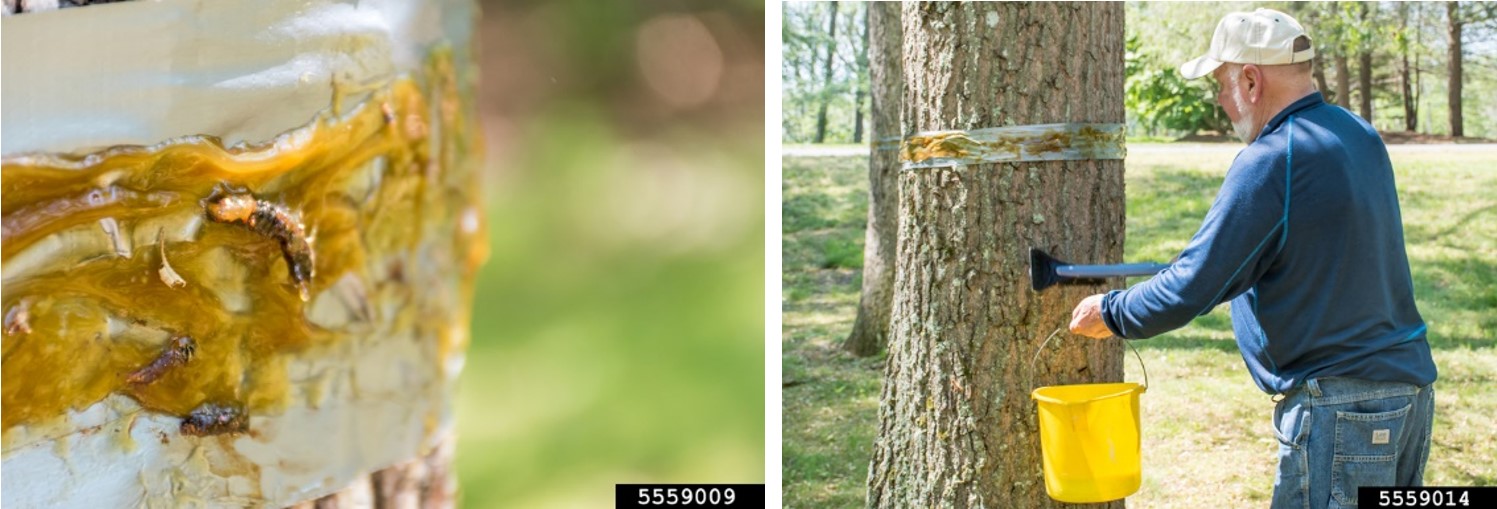
Using Bands to Protect Shade Trees from Spongy Moth
May 4, 2022 - Deborah McCullough
If you are living in the midst of a spongy moth, formerly gypsy moth, outbreak, you know it can be unpleasant. Caterpillars, which typically hatch from eggs in May, feed on the leaves of oaks and many other tree species for approximately six weeks. Oaks, aspen and many other trees can be severely or even completely defoliated. Frass, the dark greenish particles excreted by the caterpillars, may cover driveways and decks. Fortunately, by early to mid-July, caterpillars will finish feeding and spin a reddish-brown cocoon where they pupate. Adult moths emerge from the cocoons within one to two weeks, mate and each female will lay a single egg mass. Adult moths do not feed or otherwise damage trees – the caterpillars are the only life stage that will feed on leaves and excrete frass.
Bands may be an option to consider if you have a few oak trees or other “highly preferred” hosts of spongy moth in your yard. Using bands can help reduce the number of caterpillars feeding in those trees. Bands take advantage of the behavior of spongy moth caterpillars. Most moths, including spongy moth, are active in the evening and spend most of the day resting. When spongy moth caterpillars are very small, they remain up in the canopy of trees throughout the day and night. As the caterpillars get older and larger, they feed at night on leaves in the canopy of the tree. In the morning, however, many of the caterpillars crawl down the tree and look for a dark, secluded location where they can rest during the day. As it gets dark in the evening, the caterpillars move back up into the canopy to feed.

There is no need to apply bands on the trees until the caterpillars are about an inch long. At this point, they will be moving up to the canopy to feed at night and crawling down the trunk to rest during the day. When you notice caterpillars on tree trunks during the day, generally in early to mid-June, it’s time for banding. Leave the bands on the trees until most caterpillars are spinning cocoons and pupating in July.
Using a band on the trunk of a shade tree can help reduce the number of caterpillars that will feed on and defoliate that tree. Bands won’t, however, affect the overall density of the local spongy moth population in your neighborhood. Outbreaks typically collapse after 2-4 years, mainly because a virus disease and a fungus disease build up in the population (see: A Virus and a Fungus Disease Cause Spongy Moth Outbreaks to Collapse).
Hiding bands
You can construct a hiding band from burlap or similarly heavy cloth that is dark. Cut out a band of cloth that is 18-20 inches wide and long enough to completely encircle the trunk about chest high. Fasten the band around the tree trunk with twine or cord, about halfway from the lower edge of the burlap. Then let the top half of the cloth fold down over the bottom half. This allows caterpillars to hide under or between the burlap layers during the day.
Every day you will need to knock the caterpillars off into a bucket of soapy water (dish soap works fine). The soapy water will kill the caterpillars quickly. Some people use a shop vac to remove the caterpillars from under the band then empty the canister into soapy water.
If you are persistent, this can substantially reduce the number of caterpillars feeding on the banded tree. Note, however, that simply attaching the band to a tree will not reduce caterpillar numbers nor defoliation. Similarly, knocking caterpillars to the ground will have little effect – they will usually climb back up the tree.

Barrier bands
An inexpensive do-it-yourself option requires only duct tape and petroleum jelly (e.g., Vaseline). Begin by wrapping one band of duct around the circumference of the trunk of the tree about chest high. The sticky side of the tape should be against the tree bark. Go slowly and do your best to press the tape into bark cracks and crevices.
Apply a second band of duct tape around the trunk so that the lower edge of the second band overlaps the top of the first band by about an inch. Wrap a third band of duct tape around the tree, overlapping the top of the second band. All three bands should have the sticky side of the tape against the bark. The caterpillars will avoid climbing up the bands of tape and the inside, sticky surface will capture caterpillars that try to sneak underneath the bands.
Next, use your finger to smear a light layer of petroleum jelly around the second band of duct tape. The jelly band only needs to be about an inch wide. If you put a thick layer of petroleum jelly on the tape it will just melt and run down the bark on hot days. You can use Vaseline or similar petroleum jelly products, including those made from coconut oil. The band of petroleum jelly helps to reinforce the barrier if caterpillars do try to climb up the bands of tape. While the main goal of barrier bands is to prevent caterpillars from moving up the trunk to feed in the canopy at night, you can also knock caterpillars off the trunk and into a bucket of soapy water, as described above.

Sticky bands
Sticky bands are wrapped around the circumference of the trunk and ideally capture caterpillars as they move up or down the tree. Unless the bark is very smooth, you will need to use cotton batting under sticky to prevent caterpillars from crawling in the bark cracks and crevices underneath the band.
Sticky bands are sold commercially, but you can certainly make your own. Plastic stretch wrap on a handle, such as that sold by many big box stores, is ideal for making a sticky band. Begin by wrapping a band of plastic wrap around the trunk of the tree about chest high. The band should be 8-12 inches wide. As you stretch the plastic tightly around the trunk, it will adhere to itself. Once the plastic wrap is secure, you can coat the plastic with a commercially made, vegetable-based sticky material such as Tanglefoot®. You will want to wear disposable gloves to apply the sticky material. Never apply the sticky material directly to the bark of the tree. It will stain the bark and may also harm the tree.
Sticky bands eventually become less effective due to rain and weather. If sticky bands are covered with caterpillars, leaves or other debris, they will need to be replaced. Another downside of using sticky bands is that butterflies and other insects, along with small birds and even squirrels, can become trapped in the sticky material.

Slippery bands
Bands of slippery tape to wrap around tree trunks are also sold commercially. These bands are designed to prevent caterpillars from climbing up tree trunks to feed in the canopy. As with sticky bands, unless the tree has very smooth bark, you will need to put cotton batting between the bark and the band to prevent caterpillars from simply crawling underneath the band.



 Print
Print Email
Email

